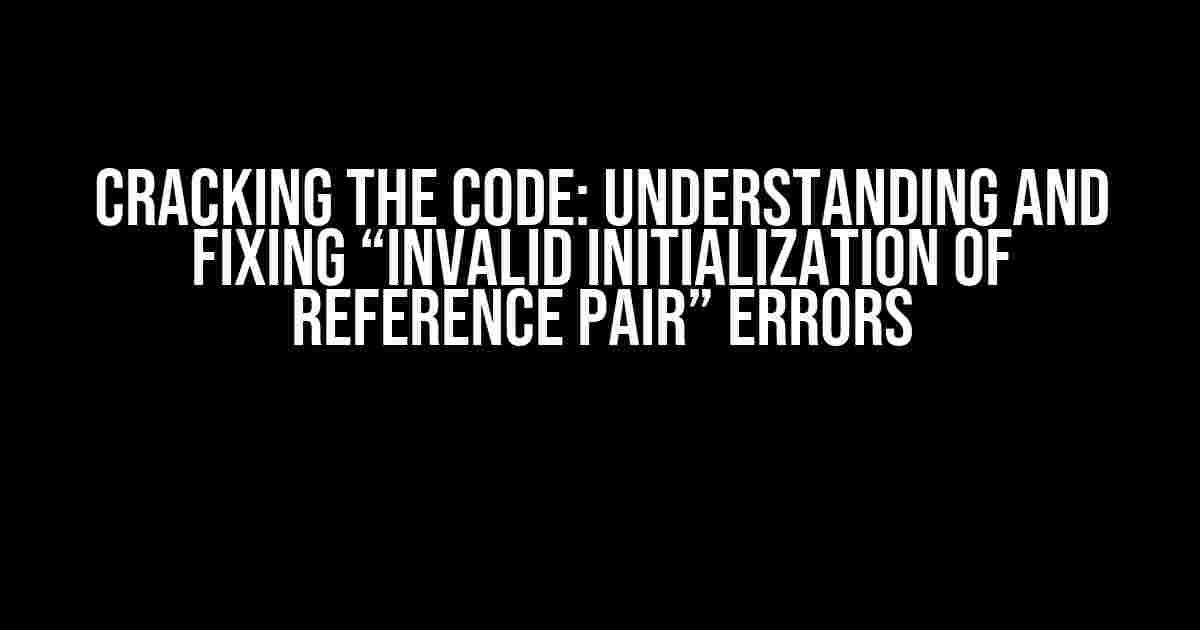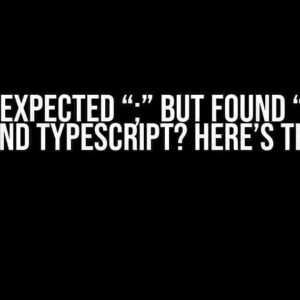In the world of C++ programming, errors can be frustrating and time-consuming to resolve. One of the most puzzling errors that programmers encounter is the “invalid initialization of reference pair” error. In this article, we’ll dive deep into the world of reference pairs, explore the reasons behind this error, and provide step-by-step instructions to fix it.
What is a Reference Pair?
A reference pair, also known as a std::pair, is a fundamental concept in C++ programming. It’s a data structure that consists of two values, often referred to as the “first” and “second” elements. Reference pairs are commonly used to return multiple values from a function, simplify data manipulation, and improve code readability.
std::pair<int, std::string> getPersonInfo() {
int age = 25;
std::string name = "John Doe";
return std::make_pair(age, name);
}
What Causes the “Invalid Initialization of Reference Pair” Error?
The “invalid initialization of reference pair” error typically occurs when you’re trying to create a reference pair with mismatched types or incompatible values. This error can manifest in various ways, including:
- Trying to create a reference pair with different data types (e.g., mixing integers and strings).
- Passing invalid or uninitialized values to the reference pair constructor.
- Using a reference pair with a non-copyable or non-movable type.
- Attempting to create a reference pair with a temporary object that has already been destroyed.
Common Scenarios that Trigger the Error
Let’s explore some real-world scenarios that can lead to the “invalid initialization of reference pair” error:
Scenario 1: Type Mismatch
std::pair<int, int> myPair = std::make_pair("hello", 42); // Error: Type mismatch between string and int
Scenario 2: Uninitialized Values
int x;
std::string y;
std::pair<int, std::string> myPair = std::make_pair(x, y); // Error: Uninitialized values
Scenario 3: Non-Copyable Type
class NonCopyable {
public:
NonCopyable() {}
NonCopyable(const NonCopyable&) = delete; // Delete copy constructor
};
std::pair<NonCopyable, NonCopyable> myPair = std::make_pair(NonCopyable(), NonCopyable()); // Error: Non-copyable type
Fixing the “Invalid Initialization of Reference Pair” Error
Now that we’ve identified the common causes and scenarios behind the error, let’s dive into the solutions:
Solution 1: Ensure Type Consistency
Make sure that the types of the values being passed to the reference pair constructor match exactly. If you’re working with different data types, consider using a heterogeneous container like std::tuple or boost::tuple.
std::pair<int, int> myPair = std::make_pair(42, 24); // Correct: Type consistency
Solution 2: Initialize Values Before Creating the Reference Pair
Ensure that all values being passed to the reference pair constructor are properly initialized. This includes primitive types, objects, and pointers.
int x = 10;
std::string y = "hello";
std::pair<int, std::string> myPair = std::make_pair(x, y); // Correct: Initialized values
Solution 3: Use Copyable or Movable Types
Make sure that the types being used in the reference pair are copyable or movable. If you’re working with non-copyable types, consider using smart pointers or unique_ptr.
class Copyable {
public:
Copyable() {}
Copyable(const Copyable&) {} // Copy constructor
};
std::pair<Copyable, Copyable> myPair = std::make_pair(Copyable(), Copyable()); // Correct: Copyable type
Best Practices for Working with Reference Pairs
To avoid the “invalid initialization of reference pair” error and ensure seamless programming, follow these best practices:
- Use consistent and compatible data types when creating a reference pair.
- Initialize all values before passing them to the reference pair constructor.
- Ensure that all types used in the reference pair are copyable or movable.
- Avoid using temporary objects that may be destroyed before the reference pair is created.
- Use std::make_pair instead of the std::pair constructor to ensure correct type deduction.
| Best Practice | Description |
|---|---|
| Consistent Data Types | Use the same data type for both elements of the reference pair. |
| Initialized Values | Ensure all values are properly initialized before creating the reference pair. |
| Copyable/Movable Types | Use copyable or movable types to avoid errors and ensure correct behavior. |
Conclusion
The “invalid initialization of reference pair” error can be frustrating, but it’s a common issue that can be resolved with a solid understanding of reference pairs and proper coding practices. By following the solutions and best practices outlined in this article, you’ll be well-equipped to tackle this error and write more efficient, error-free code.
Remember, a reference pair is a powerful tool in C++ programming, and with great power comes great responsibility. By being mindful of the common pitfalls and scenarios that lead to the “invalid initialization of reference pair” error, you’ll become a more proficient and effective programmer.
Frequently Asked Question
Are you tired of getting “invalid initialization of reference” errors and wondering what’s going on?
What causes an “invalid initialization of reference” error?
This error occurs when a reference is initialized with a temporary object or an rvalue. In C++, references must be initialized with an lvalue (a named variable or an object with a name). Make sure to check your code for any instances where you’re trying to initialize a reference with a temporary object or an rvalue.
How do I fix an “invalid initialization of reference” error?
To fix this error, you need to ensure that the reference is initialized with an lvalue. If you’re trying to initialize a reference with a function return value, consider returning a pointer instead. Additionally, check if you’re using the correct syntax for initializing references. A common mistake is to use the assignment operator (=) instead of the initialization syntax (e.g., `int& ref = x;` instead of `int& ref; ref = x;`).
Can I use a reference to a temporary object in C++?
No, you cannot use a reference to a temporary object in C++. Temporary objects are destroyed at the end of the full expression, and references to temporary objects become invalid after that. This is because references must be bound to an object with a name, and temporary objects do not have names. If you need to extend the lifetime of a temporary object, consider using a const reference or a smart pointer.
What’s the difference between an lvalue and an rvalue in C++?
In C++, lvalues (short for “left values”) are objects with a name, such as variables, arrays, or function parameters. Rvalues (short for “right values”) are temporary objects, literals, or function return values. Lvalues can appear on the left side of an assignment, while rvalues cannot. Understanding the difference between lvalues and rvalues is crucial in avoiding “invalid initialization of reference” errors.
Can I initialize a reference with a literal value in C++?
No, you cannot initialize a reference with a literal value in C++. Literal values are rvalues, and references must be initialized with lvalues. Instead, consider creating a named variable and initializing the reference with that variable. For example, `int x = 5; int& ref = x;` is valid, but `int& ref = 5;` is not.


